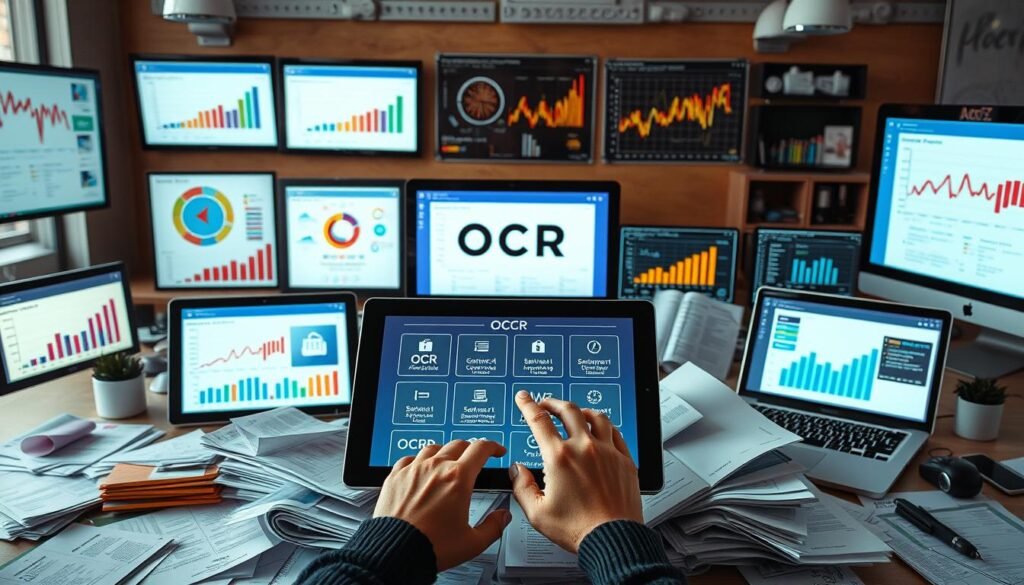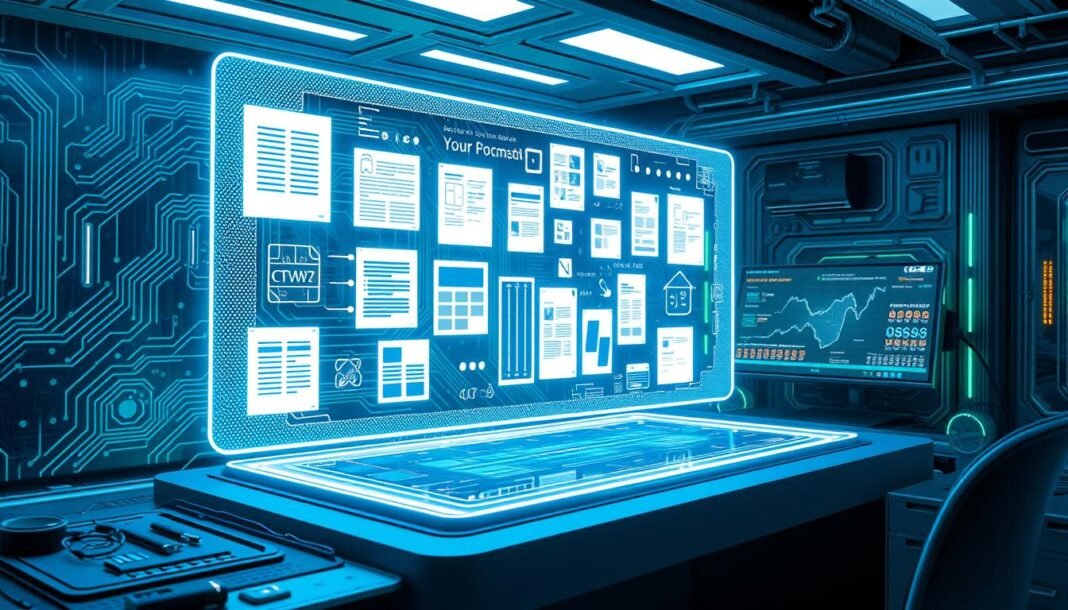In today’s fast world, OCR technology is key for quick document handling. Optical Character Recognition (OCR) makes it easy to turn printed and handwritten texts into digital files. This tech not only makes document handling smoother but also unlocks hidden info in many fields.
As we explore OCR further, you’ll see how it boosts work speed and accuracy in many areas.
Key Takeaways
- OCR technology simplifies the process of converting documents into digital formats.
- Enhanced text recognition leads to improved data accuracy and efficiency.
- Integrating OCR can significantly reduce paperwork and manual entry tasks.
- Various industries can benefit from automated data capture solutions.
- OCR integration supports better workflow management and information accessibility.
Introduction to OCR Technology
OCR technology, or Optical Character Recognition, is key in today’s document management. It turns images with text into formats computers can read. This makes digitizing documents much easier.
Early OCR methods were simple, using basic image processing. Now, we have advanced systems thanks to artificial intelligence and machine learning.
The ability to convert images to text is a big help for businesses and people. It makes it easy to manage and find information in scanned documents. As more places focus on going digital, using OCR technology can make things run smoother.
OCR technology helps with many tasks in different fields. It’s important for getting accurate and quick data in places like banks and hospitals. If you are looking for the best Website, you can Visit here for more information.
Using OCR technology can cut down on manual work, reduce mistakes, and save time. Knowing how it works is important for improving document management in our digital world.
What is Optical Character Recognition?
The definition of OCR is a technology that turns different types of documents into editable data. This includes scanned paper, PDF files, or images from digital cameras. It uses character recognition technology to read and understand text from these images. This makes it easier for businesses and people to find important information quickly.
Optical Character Recognition works in several steps. First, it improves the quality of the scanned image. Then, it breaks down the image into individual characters or words. Finally, it matches patterns in the image to known characters using special algorithms.
OCR technology is great at handling many types of documents. It works well with both printed and handwritten materials. This makes it useful in many industries, making tasks like data entry or record keeping easier.
To measure how well OCR works, we look at its accuracy. Things like recognition rates and error rates are key. High accuracy is important for text extraction in work settings. It ensures the information from documents is reliable and useful.
The Importance of Document Scanning
Document scanning is key for today’s businesses. It makes storing, finding, and sharing important documents easier. By turning paper documents into digital ones, it helps companies work more smoothly.
Creating digital copies of documents is crucial for archival processes. These digital records help meet legal standards and keep data safe. They also reduce the chance of losing important information and improve security.
Using document scanning to cut down on paper also helps the environment. It makes offices greener and reduces carbon emissions. This shows how important scanning is for both efficiency and caring for our planet.

| Benefit | Description |
|---|---|
| Easier Access | Digital files can be accessed quickly from any device. |
| Space Efficiency | Reduces the need for physical storage space. |
| Data Security | Digital records can be encrypted and backed up. |
| Regulatory Compliance | Helps maintain adherence to legal documentation requirements. |
Benefits of Data Extraction with OCR
Using OCR technology for data extraction offers many benefits to businesses today. It makes text recognition faster and more accurate. This means companies can quickly turn scanned documents into formats they can edit.
This process also cuts down on mistakes that come from manual data entry. It’s a big plus for businesses looking to improve their work.
OCR helps automate the capture of data from different sources. This includes things like invoices, receipts, and forms. As a result, businesses save a lot of time, which is good for their bottom line.
They also don’t have to do the same tasks over and over. This lets staff focus on more important work.
OCR technology has real-world benefits. For example, banks use it to process lots of documents fast. This makes their work more efficient.
Healthcare also benefits from OCR. It helps digitize patient records, which improves care.
The table below shows the main benefits of using OCR for data extraction:
| Benefit | Description | Impact |
|---|---|---|
| Text Recognition Efficiency | Fast and accurate conversion of printed text into digital format. | Reduces errors and accelerates document processing. |
| Automated Data Capture | Automatic extraction of text from various documents. | Streamlined data entry, freeing up valuable staff time. |
| Operational Efficiency | Improved workflows by integrating OCR into business processes. | Lower costs and enhanced productivity overall. |
| Data Accuracy | Minimized human intervention reduces potential for mistakes. | Ensures higher quality and reliability of data. |
Adding OCR to business systems changes how companies handle documents and data. It’s a step towards a more efficient future.
How OCR Technology Integration Enhances Workflow
Adding OCR technology to workflows makes them better and more productive. It automates tasks like document routing and data entry. This saves time and cuts down on mistakes, letting workers do more important tasks.
Working well with systems like ERP and CRM is key to being efficient. OCR technology helps these systems work together smoothly. This makes the workflow better, making the company more flexible and quick to respond.
Studies show that using OCR makes document management better. Tasks that took hours now take just minutes. This lets companies quickly meet new market needs. Better workflow means lower costs and happier customers.
- Automation of repetitive tasks saves time and resources.
- Reduction in manual entry errors enhances data accuracy.
- Quick access to information improves decision-making.
- Integrated systems provide a unified approach to workflow management.
As businesses focus more on being efficient, using OCR technology is a big help. It lets companies improve their processes and stay ahead of the competition.
Applications of OCR: From Banking to Healthcare
OCR technology is used in many industries, changing how data is handled. It makes banking and healthcare work better by making processes faster and more accurate. This technology helps reduce mistakes made by people.
Using OCR for Invoice Processing
OCR is key in invoice processing. It helps solve the problem of manual data entry errors. By using OCR, companies can quickly get data from invoices, speeding up payments.
Using OCR for invoices has many benefits:
- Increased accuracy: Fewer mistakes because of less manual work.
- Speed enhancement: Faster processing means quicker payments.
- Cost reduction: Saves money by needing less labor for data entry.
OCR in Medical Records Management
The healthcare field is also using OCR for managing medical records. It makes it easier to find patient information quickly. This helps doctors make better decisions faster.
OCR in healthcare brings many advantages:
- Improved access: Finds patient records fast, helping in decision-making.
- Enhanced organization: Digital records save space and are easier to manage.
- Streamlined communication: Makes sharing patient info between doctors easy.
OCR in banking and healthcare shows big improvements in efficiency and accuracy. By using OCR, these industries work better and serve customers more effectively.
| Industry | OCR Application | Benefits |
|---|---|---|
| Banking | Invoice Processing | Increased accuracy, speed enhancement, cost reduction |
| Healthcare | Medical Records Management | Improved access, enhanced organization, streamlined communication |
Challenges in Implementing OCR Technology
Using OCR technology comes with its own set of challenges. Knowing these can help businesses get ready for it.
One big problem is the accuracy issues with different documents. How clear the text is affects OCR’s performance. Bad scans or handwritten texts can cause a lot of errors, making the tech less effective.
Cost considerations are also a big deal. Starting with OCR can be expensive. You have to think about the cost of software, hardware, upkeep, and updates.
Setting up OCR can be tricky. It needs a smart plan to work with current systems. Sometimes, old systems don’t work with new OCR, which means more money for updates or new systems.
Teaching staff how to use OCR is key but often forgotten. Without good training, OCR’s full potential might not be reached. Bad training can lead to more errors and slow down work.
| Challenge | Description | Impact |
|---|---|---|
| Accuracy Issues | Variability in performance based on document quality. | Errors in data entry affecting overall outcomes. |
| Cost Considerations | High initial investment for software and hardware. | May deter smaller organizations from adopting OCR. |
| Implementation Barriers | Integration with existing systems can be complex. | Possible need for additional technology upgrades. |
| Staff Training | Insufficient training results in poor usage of the technology. | Decreased operational efficiency and errors in processing. |
By tackling these challenges early, organizations can get the most out of OCR technology. This boosts their ability to handle documents better.
Future Trends in Intelligent Document Processing
The world of intelligent document processing is changing fast. New trends are emerging, thanks to AI in OCR. This makes old document recognition systems much better.
Improved OCR models are on the horizon. They promise to be more accurate and efficient. This means they can handle more types of documents, opening up new uses in different fields.
NLP is also becoming part of OCR systems. This tech doesn’t just read text; it understands it too. It makes data extraction smarter and more meaningful. The mix of AI and NLP will make documents smarter, helping companies get more from their data.
Automation is also changing how we deal with documents. It reduces the need for humans to get involved, making things faster and more efficient. Businesses are now investing in automated tools to stay ahead in a world where data is key.
Looking ahead, OCR technology will get even better. With advanced AI and automation, intelligent document processing will become essential. It will help companies work better and manage their data more effectively.
How to Choose the Right OCR Solution
Choosing the right OCR solution is key to boosting productivity and efficiency. Look at how well it fits with your current systems, if it can grow with your needs, and how easy it is to use. Also, check if there’s good support available. These factors help you pick the best solution for your organization.
Factors to Consider
- Compatibility: Make sure the OCR solution works well with your current software and hardware.
- Scalability: Choose options that can grow with your document processing needs.
- User-Friendliness: A simple solution means less training time and easier adoption.
- Support Services: Good customer support is crucial for overcoming any challenges.
Top OCR Technologies on the Market
| OCR Technology | Key Features | Strengths | Weaknesses |
|---|---|---|---|
| ABBYY FineReader | Multi-language support, PDF editing | High accuracy, popular among enterprises | Can be pricey |
| Adobe Acrobat Pro DC | Document collaboration, form creation | Well-known, versatile | Lacks some advanced OCR features |
| Tesseract | Open-source, customizable | Free, strong community | Needs technical skills |
| Google Cloud Vision | AI-powered, image analysis | Scalable, innovative | Dependent on internet connection |

Conclusion
OCR technology brings many benefits to document management. It automates data extraction, reducing manual work. This makes processes smoother, cuts down on mistakes, and boosts efficiency.
As OCR technology advances, it will become even more useful for businesses. Companies that use OCR well will stay ahead in the market. They will meet changing needs and keep their competitive edge.
Exploring OCR solutions can change how businesses work. It leads to better efficiency and productivity. Now is the time to see how OCR can improve your document management and help your business succeed.










